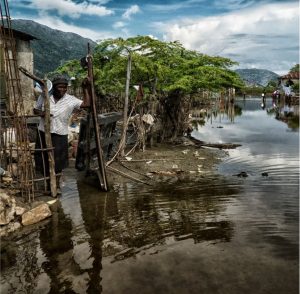 Governments must integrate work across frameworks if global policy won’t, say Zenaida Delica-Willison and JC Gaillard. Disasters are a serious challenge everywhere. All communities need resilient and sustainable development, and that cannot be achieved without thinking through Disaster Risk Reduction (DRR) strategies. But many years of discussion and work on DRR have been side-lined by policy makers since climate change emerged as a global priority.
Governments must integrate work across frameworks if global policy won’t, say Zenaida Delica-Willison and JC Gaillard. Disasters are a serious challenge everywhere. All communities need resilient and sustainable development, and that cannot be achieved without thinking through Disaster Risk Reduction (DRR) strategies. But many years of discussion and work on DRR have been side-lined by policy makers since climate change emerged as a global priority.
A great, and possibly unique, opportunity to align these agendas has been lost this year: landmark summits for disasters, development and climate are all being held separately.
In March, 187 countries signed the Sendai Framework for Disaster Risk Reduction 2015-2030 — which provides some limited guidance for integrating climate change into DRR within the broader context of development. Then, in late September, the UN Sustainable Development Summit endorsed 17 new development goals for 2030 — including Goal 13 on climate change without a reference linking it to DDR.
And in December, Paris will host the 21st Conference of the Parties (COP21) to the UN Framework Convention on Climate Change (UNFCCC) — an event likely to focus on long-term limits on emissions, not on adapting to change now, or on everyday development priorities.
This policy separation undermines action, and leaves national and local governments to pull the three together.
Climate change distractions
In fact, DDR research and policy took changing climate patterns and ‘extreme events’ into account long before the UNFCCC and Intergovernmental Panel on Climate Change were established.
For example, in the Philippines, the Citizens’ Disaster Response Centre and partner communities have been using evidence to identify DRR strategies that adapt to climate change since the early 1980s — it just wasn’t called ‘adaptation’.
 The problem with focusing primarily on climate change is that it diverts attention away from other issues associated with disaster risk and poor development. For instance, many countries factor sea level rise into flood risk reduction policy but ignore land subsidence caused by humans — a much more immediate threat. So although subsidence is already hitting the Philippines and other Asian countries, governments have yet to tackle the uncontrolled and excessive groundwater extraction causing it.
The problem with focusing primarily on climate change is that it diverts attention away from other issues associated with disaster risk and poor development. For instance, many countries factor sea level rise into flood risk reduction policy but ignore land subsidence caused by humans — a much more immediate threat. So although subsidence is already hitting the Philippines and other Asian countries, governments have yet to tackle the uncontrolled and excessive groundwater extraction causing it.
Other overlooked causes of disaster risk include being poor and being ‘marginalised’ in society. They both make people vulnerable and less able to face climate hazards. Often, the resources people need to face hazards are available locally, but only to those with a stronger economic, political and social position.
No disaster causes all buildings to collapse or everyone to die — there are always buildings spared and people who survive. This reflects the unequal distribution of power, which similarly influences who can adapt to climate change and who cannot.
Short-term needs prevail
In reality, people’s vulnerability and ability to adapt to climate change are grounded in everyday life and short-term development concerns, such as securing food, paying bills and maintaining social relationships.
For example, many coastal fishermen in the Philippines will not hesitate to set out to fish despite an impending cyclone if this is the only means of putting food on the table for the week. Yet climate change policies usually ignore these short-term priorities.
Instead, they focus on long-term impacts, and investments that are often limited to infrastructure. Take the sea walls and water tanks constructed in Kiribati: they protect against drought and storms; but at the expense of investments into addressing people’s everyday food and health concerns.
Ultimately, meeting food and health needs will support people’s ability to face climate change. And it will help them choose, consciously and individually, whether or not they want to migrate — a solution suggested by many scholars and aid agency consultants.
Sometimes, investments in adaptation actually conflict with indigenous strategies to cope with climate hazards. The very idea of institutional planning for long-term adaptation, often imposed by aid agencies, is alien to many societies of the Pacific. Their traditional systems of governance are dominated by day-to-day decision making. Disrupting that threatens traditional strategies that work — the people of Tikopia in the Solomon Islands have overcome scores of powerful cyclones on their own over many centuries.
There is another downside to focusing on climate change rather than DRR: it often provides an easy escape for governments and organisations looking to evade responsibility for creating broader disaster risks. After the devastating floods that affected Jakarta in February 2007, for example, the Indonesian government quickly pointed to climate change — a global process beyond the state’s reach.
Countries must lead on integration
Given that DDR, climate change and development have already been separated in the global policy arena, national and local governments must now take the lead. Their development policies need to pull together the outcomes and recommendations from all three policy processes.
It can be done: in the Pacific, Tonga has pioneered the integration of DRR and adaptation, and it did so without major institutional reorganisation even though climate change is usually seen as an environmental issue and DRR as a civil defence issue. To facilitate a single approach, local leaders created the Task Force for Disaster risk Management and Climate Change Adaptation.
Of course, climate change remains crucially important — ignoring it would miss an important dimension of disasters and development. But integrating efforts to adapt to it into disaster risk reduction work, and eventually including both within the broader development agenda, is imperative for achieving better-off and more resilient communities.























































